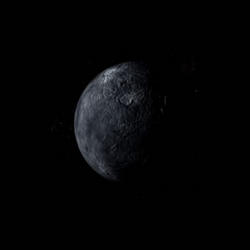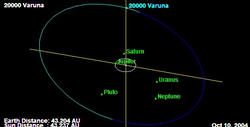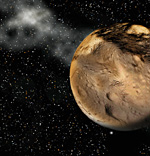Varuna
New Planet 2000!!!
Observations within the last decade have revealed the existence of a large number of bodies in orbit about the sun beyond Neptune. These bodies, commonly known as Kuiper Belt Objects (KBOs), are products of agglomeration in the rarefied outer regions of the protoplanetary disk of the sun. Scientific interest focuses on the primitive nature of the KBOs and on their role as the likely source of short-period comets. Unfortunately, the KBOs are difficult astronomical targets, so that even such basic physical properties as the sizes and albedos remain unknown. Here we report the first simultaneous thermal and optical measurements of a bright KBO and use them to solve separately for the albedo and size. (20000) Varuna has equivalent circular diameter D = 900(+125/-145) km and red geometric albedo p = 0.070(+0.030/-0.017). The surface is darker than Pluto, suggesting a composition largely devoid of fresh ice, but higher than the canonical albedo of 0.04 previously assumed for these bodies.
20000 Varuna ("VAR oo na") is a large classical Kuiper Belt object.
It is named after the Hindu god Varuna. It previously had the provisional designation 2000 WR106 and has been precovered in plates dating back to 1953. Under the International Astronomical Union's 2006 draft proposal for the definition of a planet, Varuna would be labelled a dwarf planet if it were proven to be spherical.
| Discovery A | |
|---|---|
| Discoverer | R. McMillan (Spacewatch) |
| Discovery date | 28 November 2000 |
| Alternate designations B | 2000 WR106 |
| Category | Kuiper belt |
| Orbital elements C | |
| Epoch 14 July 2004 (JD 2453200.5) | |
| Eccentricity (e) | 0.051 |
| Semi-major axis (a) | 6451.398 Gm (43.129 AU) |
| Perihelion (q) | 6120.810 Gm (40.915 AU) |
| Aphelion (Q) | 6781.985 Gm (45.335 AU) |
| Orbital period (P) | 103440.6 days (283.20 years) |
| Mean orbital speed | 4.53 km/s |
| Inclination (i) | 17.2° |
| Longitude of the ascending node (Ω) | 97.296° |
| Argument of perihelion (ω) | 271.631° |
| Mean anomaly (M) | 89.673° |
| Physical characteristics D | |
| Dimensions | 936 +238−324 km |
| Mass | ~5.9×1020 kg |
| Density | ~1 g/cm³ |
| Surface gravity | 0.15 m/s² |
| Escape velocity | 0.39 km/s |
| Rotation period | 0.26432 days (3.17 hours) |
| Spectral class | (moderately red) B-V=0.93 V-R=0.64) |
| Absolute magnitude | 3.7 |
| Albedo (geometric) | 0.037 +0.011−0.014 |
| Mean surface temperature | ~43 K |



